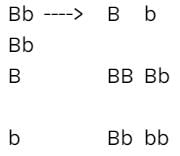Genetics (Pedigree Analysis) MCQ Test - Botany, Class 12 - Class 12 MCQ
30 Questions MCQ Test - Genetics (Pedigree Analysis) MCQ Test - Botany, Class 12
If a cross is made between two individuals, each having genotype Bb, two offsprings are obtained. Out of these first has dominant trait. What is the probability that the second offspring will exhibit recessive trait?
In case of taster and non-taster human beings T is for dominance & t is for recessive gene. Which of the following would not be able to taste PTC :-
| 1 Crore+ students have signed up on EduRev. Have you? Download the App |
A family has five girls and no son, the probability of the occurance of son in 6th child is :-
A tobacco plant heterozygous for albinism is selfpollinated and 1200 seeds are subsequently germinated. How many seedlings would have the parental genotype :-
Which one of the following character in man is controlled by recessive gene :-
A child is born with an extra chromosome in each of its cell, this condition is the result of :-
Any changes in gene frequency in a population is called :-
The migration of gene in to a population from other population by inter breeding is called
What is the probability of three daughters to a couple in three children :-
In human right handedness is dominant over left handedness. What offsprings would be expected from two left handed parents :-
In man, gene producing the disease phenyl ketonuria also produces a number of abnormal phenotypic traits, which are collectively syndrome.This gene results mental retardation, widely spaced incisors, pigmented patches on the skin and excessive sweating such types of genes are called
Human embryo all the genetic instructions, it needed to become a male or female. The male foetus have a master gene which acts as a biological switch, turning other genes on and off. Loss of this gene results in female which remain sexually immature. This master gene is located on :-
In a Random mating population of 28,800 individuals percentage of dominant homozygous individuals is 49 find out the percentage of heterozygous individual –
Predict from the following chart
In pedigree analysis symbol ⨀ is used for
In the absence of mutation, migration and selection if gene frequencies are changed in a population.This change is due to :-
The pedigree shows the occurence of albinism which is a recessive trait. If person 4 is homozygous, the carrier for the trait is :-
This is paedigree for autosomal recessive disease albinism (aa) what is probability of II – I is homozygous Normal
Albinism in human is controlled by a recessive gene 'a' If both parents were known to carrier (Aa) for albinism. What is the chances of 1 normal and 3 albino in family of four :-
Which of the following restriction endonuclease enzyme produce blunt end in DNA :–
A bacterium modifies its DNA by adding methyl groups to the DNA, It does so to :-
A male is heterozygous for autosomal gene A, B and G . He is also homozygous for hemophilic gene h. What proportion of his sperm will be abgh:-
The genotype of Rh+ person could be :–
In a population that is in Hardy weinberg equilibrium, the frequency of a recessive allele for a certain hereditary trait is 0.20. What percentage of the individual in the next generation would be expected to show the dominant trait :-
Given pedigree shows inheritance of autosomal recessive gene. What is the genotype of given parents :-
Bt–cotton is resistant for :-
A pedigree is shown below for a disease that is autosomal recessive. The genetic make up of the first generation :-
In a random mating population frequency of disease causing recessive allele is 80%. What would be the frequency of carrier individual in population :-
Haemolytic jaundice is due to dominant gene but only 20% of the people develop this disease. A heterozygous man marries a homozygous normal woman. What proportion of the children in population would be expected to have this disorder:-


















